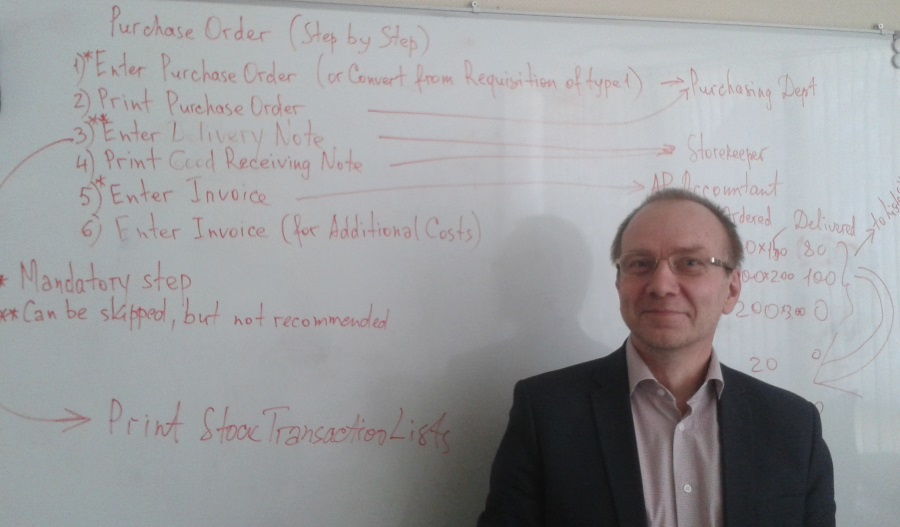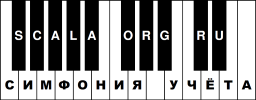Of course, in different companies, iScala users work differently, but nevertheless, there is a standard system logic that needs to be taken into account.

| 0 | Create purchase order proposal or create and approve requisition of type 1 | No | When creating proposal, records are created in the order header and order lines tables, when you enter the requisition, records are created in the header and requisition lines tables |
| 1 | Enter purchase order or convert proposal into purchase order, or convert requisition into purchase order | One of the listed options must be fulfilled | When you enter an order, as well as when converting a requisition into an order, records are created in the header and order lines tables. When converting a proposal into an order, the already existing information in the order header and order lines is updated. In addition, there is an update in the stock planning table |
| 2 | Print Purchase Order | No | In addition to printing a document, the information (flag) is updated in the order header indicating that the order is printed |
| 3 | Print order confirmation reminder (for the supplier) | No | The information (flag) is updated that the reminder is printed |
| 4 | Entering the order confirmation (from the supplier side) | No | It is used rarely, only when they want to see the expected delivery date when looking at the expected receipts: the delivery date confirmed by the supplier: the stock planning is updated |
| 5 | Print delivery confirmation reminder | No | The information (flag) is updated that the reminder is printed |
| 6 | Print Other documents | No | |
| 7 | Enter Delivery Note | This step, in principle, is not necessary, but in practice, it is almost always fulfilled, because for this step the storekeeper is usually responsible, and for entering the invoice, the accountant | A new batch is created for Stock Item. New analitical transaction is created for stock reseiving from supplier (Transaction type 00). The quantity of stock item in the warehouse changes. If the «Weighted average price» stock model is used, the weighted average price can be changed (If the purchase price differs from the weighted average price of the stocks). The stock planning changes (the expected receipt is reduced by the received amount). The information in the order header and order lines is changed, a record or records are created in purchase order delivery lines table |
| 8 | Print Goods Receiving Note | No | The information (flag) is updated that the GRN is printed |
| 9 | Enter Invoice | Yes | Depends on whether Step # 7 was completed. If not, then all the actions described for step 7 take place. Additionally, an entry is created in the supplier invoice table, VAT table for supplier invoices, the balance of the supplier is updated, accounting transaction is created in the invoice journal of «Purchase Ledger» module (In the hospitality version, this module is called «Accounts payable»). Fully invoiced lines «go» to the history, partially invoiced lines «go» to the history partially (In the order line there will be an uninvoiced quantity, for example, if 100 was ordered, and 80 is delivered and invoiced, 80 will go to the history, and 20 will remain in the order line. There is a special parameter on which it depends whether to save the history for the invoiced orders. If there is a difference between the Delivery Note amount (without VAT) and the invoice amount, this difference is allocated to the value of received stock items (transaction of type 03 is created in the «Stock Control» module). Also transaction type 03 can be created if consolidation currency is differs from the local currency or if Purchase Order currency differs from the local currency. This can occur if the delivery note date and invoice date is different and the exchange rates on these dates also differ. |
| 10 | Entering invoices for additional costs (for example, transportation, loading / unloading, customs duties, etc.) | No | Record is created in the supplier invoice table, VAT table for supplier invoices, the balance of the supplier is updated, accounting transaction is created in the invoice journal of «Purchase Ledger» module («Accounts payable»). Cost Amount is allocated to the value of received stock items (transaction of type 03 is created in the «Stock Control» module) |
And now some comments on what will happen if you make changes to the order at different steps:
If the user decides to make changes of the purchase price on the order line, then:
- In steps 0 — 6, the price in the order line will change
- After step 7, but before step 9 — iScala automatically creates stock transaction for the difference in the price of received stock items.
- After step 9, the price in the line will change (if after the step 9 the new delivery was not entered)
If step 9 has not yet been executed, delivery entered by mistake can be adjusted by entering an additional (or negative) quantity in step 7 (entering the delivery note), If step 9 (Entering an invoice) is already executed, then you will have to enter a new order with a negative amount.
If you have any questions, do not hesitate to ask:
Other procedures and articles in English:
- Структура таблиц / Table structure Epicor iScala 3.5 (x64) — 3.5.0.0429
- Что должно быть настроено в системе, чтобы при печати счетов-фактур в модуле «Заказы на Продажу» создавались XML файлы? / What should be configured in the system if we want XML files to be created when printing invoices in the Sales Orders module?
- Структура таблиц / Table structure Epicor iScala 3.4 (x64) — 3.4.0399
- Scala/iScala и электронная отчётность в России | Scala/iScala and e-reporting in Russia
- Добавлено описание структуры таблиц БД iScala 3.3 / A description of iScala 3.3 DB tables structure has been added
- Структура таблиц / Table structure Epicor iScala 3.3 (x64) — 3.3.0419
- Looking for the perfect ERP system. iScala’s strengths and weaknesses
- About different approaches to implementing iScala one more time
- Структура таблиц / Table structure Epicor iScala 3.2 (x64) — 3.2.0317
- AFR: Как сделать расчёт значения в столбце зависимым от номера строки? :: AFR: How can I calculate the value in a column dependent on the line number?
- Query execution failed for dataset ‘DataSet0’
- Структура таблиц / Table structure Epicor iScala 3.1 — 3.1.0511
- SQL Server: OLE Automation Procedures
- Знаете ли Вы, что? Новая фишка в последней версии AFR: перенумерация строк :: Do you know that? The new feature in the latest version of AFR: renumbering rows
- Multi Level Approvals for Requisitions: How it works?
- MSRS channel — what to use instead in case of very old version of Scala/iScala?
- How to add a document template for MSRS Output Channel
- Заявление / Memorandum
- Deploy existing AFR reports on another server
- How to delimit user access on the Reporting Server?
- Standard steps when working with the «Purchase Order» module
- Изменение структуры таблиц iScala 3.1 по сравнению с iScala 3.0 FSP4 / Table structure changes between iScala 3.0 FSP4 and iScala 3.1
- История изменения структуры таблиц разных версий iScala / Tables structure changes history from iScala 2.2 SR2 to iScala 3.0 FSP4
- Процесс создания отчёта фиксированной формы с помощью Epicor AFR :: The process of creating a fixed-form report using Epicor AFR
- The most common mistake when working with AFR reports
- Структура таблиц / Table structure Epicor iScala 3.0 FSP4 — 3.0.4267
- AFR: что это такое, из чего состоит, с чем взаимодействует? :: AFR: what is it, what does it consist of, what it interacts with?
- Usage of external tables with primary data. How to design Daily Budget Report.
- How can I create an AFR report in 2 currencies using fixed rate?
- How to create AFR report with daily budgets from iScala?
- Типы проводок Главной Книги :: General Ledger Transaction Types
- Reporting tools usage survey
- Sent PO electronically to Supplier’s FTP site
- Requisition Management module quick user guide
- What can you get from your iScala by using new technologies?



